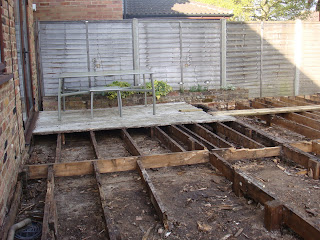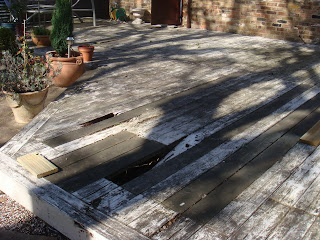So, having got rid of the old deck; it was time to turn our attention to the ordering and receiving of materials for the replacement version. We had much advice about decking materials, particularly the actual decking boards, but we decided against one of the most expensive decking boards known to mankind, otherwise known as Kebony; we did look at this, but at over £60.00 per 4.8 metre deck board we thought this was not for us (we needed 70 of these long boards plus some shorter ones; so going for the Wickes offering with a 33% discount for bulk purchase at £8.68 each for the long boards turned out quite a bit cheaper; I will leave you to do the maths !).
Also, as indicated by the title of this blog, we needed quite a lot more than just the top layer of deck board; and our initial Wickes shopping list was for:-
70 x 4.8 metre deck boards; 20 x 3.6 metre deck boards; 44 x 3 metre heavy duty decking joists; 15 x 1.2 metre decking posts; 6 rolls of Heavy Duty Landscape Fabric; 1 x Jumbo Bag of Pea Shingle; 1 x Large Tin of Clear Decking Preserver.
As this was rather a large order, and Wickes will only deliver to the kerbside, we asked for this order to be split into two consignments; in theory giving us a rest between deliveries and a chance to get started on some of the ground work before the decking boards arrived !!
Regrettably, when the day for the first delivery arrived we found that the driver had got our complete order - except for 1 of the shorter deck boards and the Pea Shingle - so rather than send him away we accepted the whole order and then had to spend several hours moving everything to the back garden.
Having had a chance to look at the actual deck boards during this process, we noticed that quite a number were not acceptable, with large knot holes and large splits and other unsightly markings.
So, we called them up and listed the boards we thought were unacceptable (15 of the long boards and 10 (50%) of the shorter boards). Somewhat surprisingly, and this is where Wickes was very good, our opinion was not questioned and Wickes agreed to replace all the faulty boards when delivering the outstanding items.
They also agreed to take away the faulty boards, and we therefore carried these 25 boards back out the front for the next scheduled delivery; this time, although the driver had our replacement boards, and the missing 3.6m board, (and some concrete fence posts that we had not ordered and which we rejected), he still had no pea shingle and, worse than that, he had had no instructions to take away any faulty material; so we had to carry both new good boards and old faulty boards back to the rear garden.
The saga regarding the delivery of the pea shingle then went on for a further few weeks (during which period we had visitors) but finally it was delivered and all materials were to hand for the project.
The pictures below were taken before the arrival of the pea shingle, so if you could use your imagination for a Jumbo Bag that would be helpful !

So now we have removed the old deck, and have all the materials for the replacement project to start; I also bought myself a new cordless drill/screw driver (and a large tub of external grade screws), and a large mains powered circular saw (with laser guide); so watch this space for the start of the re-construction work, in Blog the Forth coming











